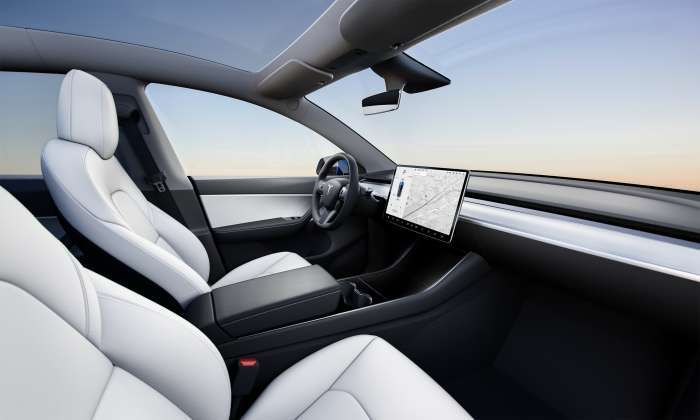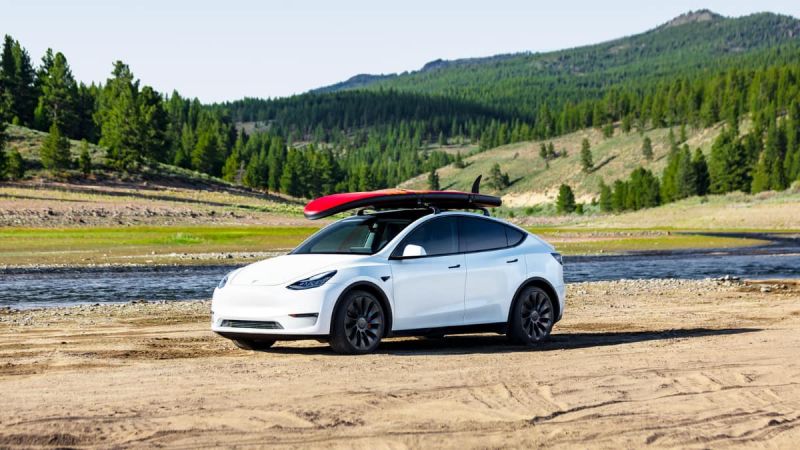According to data provided by CPCA, and shared by 42HOW, the Model Y sold 13,313 units in October, followed by Mercedes GLC with 12,620 and BMW X3 with 11,243 units. If we take into account monthly sales from January to October, the Chinese car Hongguang Mini is at the top, Tesla Model 3 is second, and Tesla Model Y is in third position; even though there is obviously a huge difference in category and segments between the Hongguan Mini EV and the Teslas.
For starters, the Wuling Hongguang Mini EV is an all-electric microcar manufactured by SAIC-GM-Wuling (since 2020); it is equipped with a 9.2 kWh battery capable of a NEDC range of 120 km (75 mi) or a 13.8kWh battery capable of a NEDC range of 170 km (110 mi); clearly, we can not compare it to a Tesla Model 3 or Model Y. The Hongguang Mini can seat four people and is powered by a single electric motor producing 13 kW (17.4 hp) and 85 Nm (62.7 lbf.ft) of torque with rear-wheel drive. It has a top speed of 100 km/h (62 mph). Based on the NEDC driving cycle, the estimated energy consumption of the Wuling Hongguang Mini EV is 8,1 kWh/100 km.

Now, the Tesla Model Y can reasonably be compared to a Mercedes GLC and/or a BMW X3. The Mercedes-Benz GLC-Class (X253/C253) is a compact luxury crossover SUV introduced in 2015 for the 2016 model year that replaces the GLK-Class. According to Mercedes-Benz, it is the SUV equivalent to the C-Class. Under the vehicle naming scheme maintained by Mercedes-Benz, SUVs use the base name "GL", followed by the model's placement in Mercedes-Benz hierarchy. The "G" is for Geländewagen (German for off-road vehicle) and alludes to the long-running G-Wagen. This is followed by the letter "L" that acts as a linkage with the letter "C" to signify that the vehicle is a SUV equivalent to the C-Class.
Tesla Model Y is October’s Top Selling High-End SUV in China.
Monthly Sales Volume October 2021:
1st Tesla Model Y - 13,303 units
2nd Mercedes GLC
3rd BMW X3
Monthly Sales Volume January-October 2021:
1st Hongguang Mini
2nd Tesla Model 3
3rd Tesla Model Y#Tesla #ModelY $TSLA pic.twitter.com/k02xaZoJ9W— 42HOW (@42how_) November 9, 2021
As for the BMW X3, it is a compact luxury crossover SUV manufactured by German automaker BMW since 2003. The third generation is codenamed G01 and was unveiled in June 2017. Drivetrains include two 2.0-litre diesel units known as B47, a next-generation 3.0-litre diesel engine (B57), and a petrol variant (B58): a gasoline-powered, turbo-charged straight-six with a displacement of 2,998 cc and a plug-in hybrid. In 2019, the X3 xDrive 30e (which shares it's powertrain and platform with the G20 330e xDrive) iPerformance model was introduced, sharing its engine with the X3 sDrive20i/xDrive20i and a 50 kW (67 hp) electric motor; having a maximum electric range of 27–30 mi (43–48 km). It has a 12 kWh battery (9.6 kWh usable) along with a newly developed system called "XtraBoost" which allows for a temporary power increase from the electric motor of up to 30 kW (40 hp).

As we can see, and despite Tesla Model Y (and Model 3) being a full BEV as compared to the other two (and by the way, having never been involved in any "diesel-gate" kind of scandal, obviously), the numbers coming from China in October 2021 certainly show a bright future (and present) for electric vehicles.
All images in this article, courtesy of Tesla Inc.
Nico Caballero is the VP of Finance of Cogency Power, specializing in solar energy. He also holds a Diploma in Electric Cars from Delft University of Technology in the Netherlands, and enjoys doing research about Tesla and EV batteries. He can be reached at @NicoTorqueNews on Twitter. Nico covers Tesla and electric vehicle latest happenings at Torque News.











